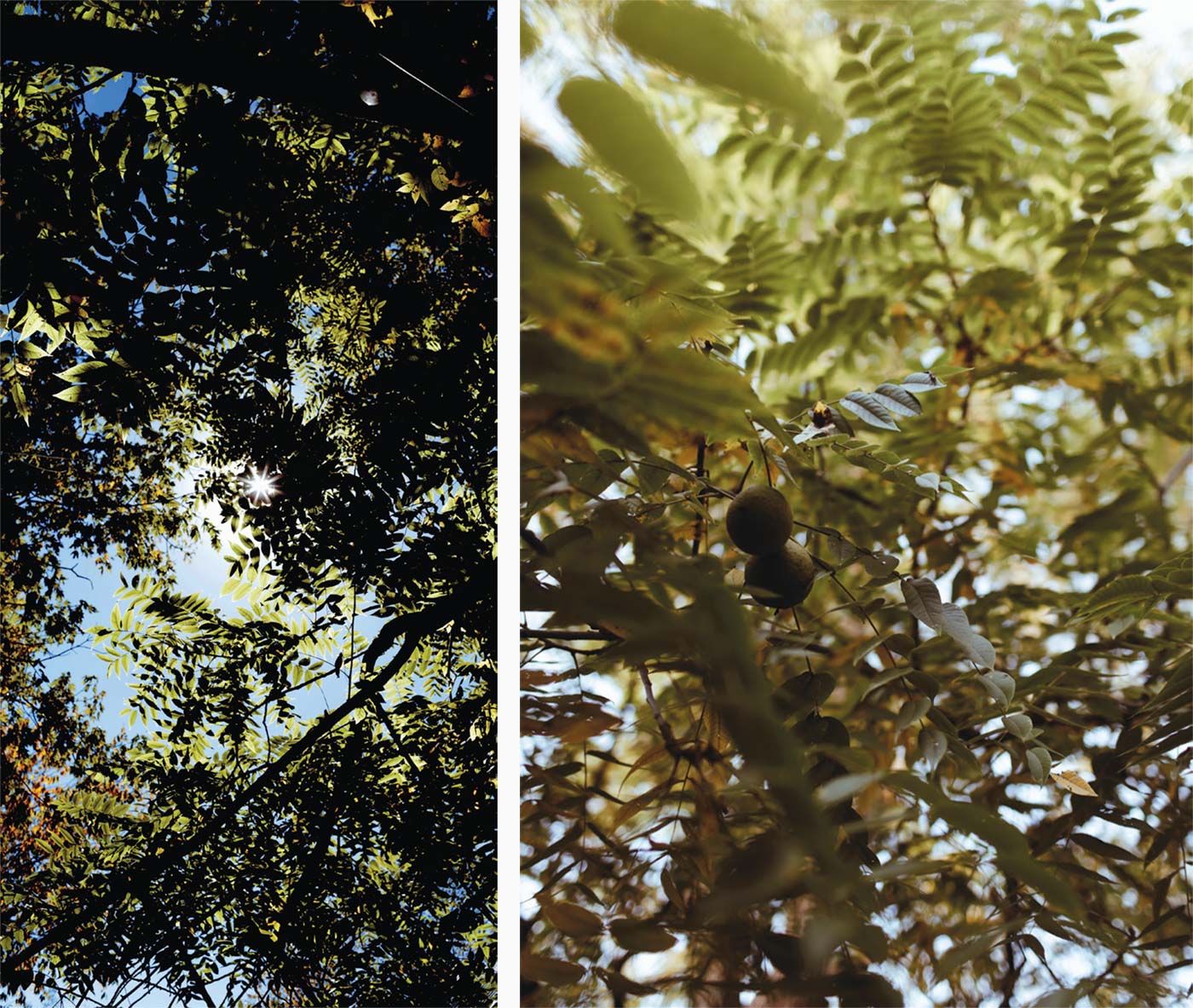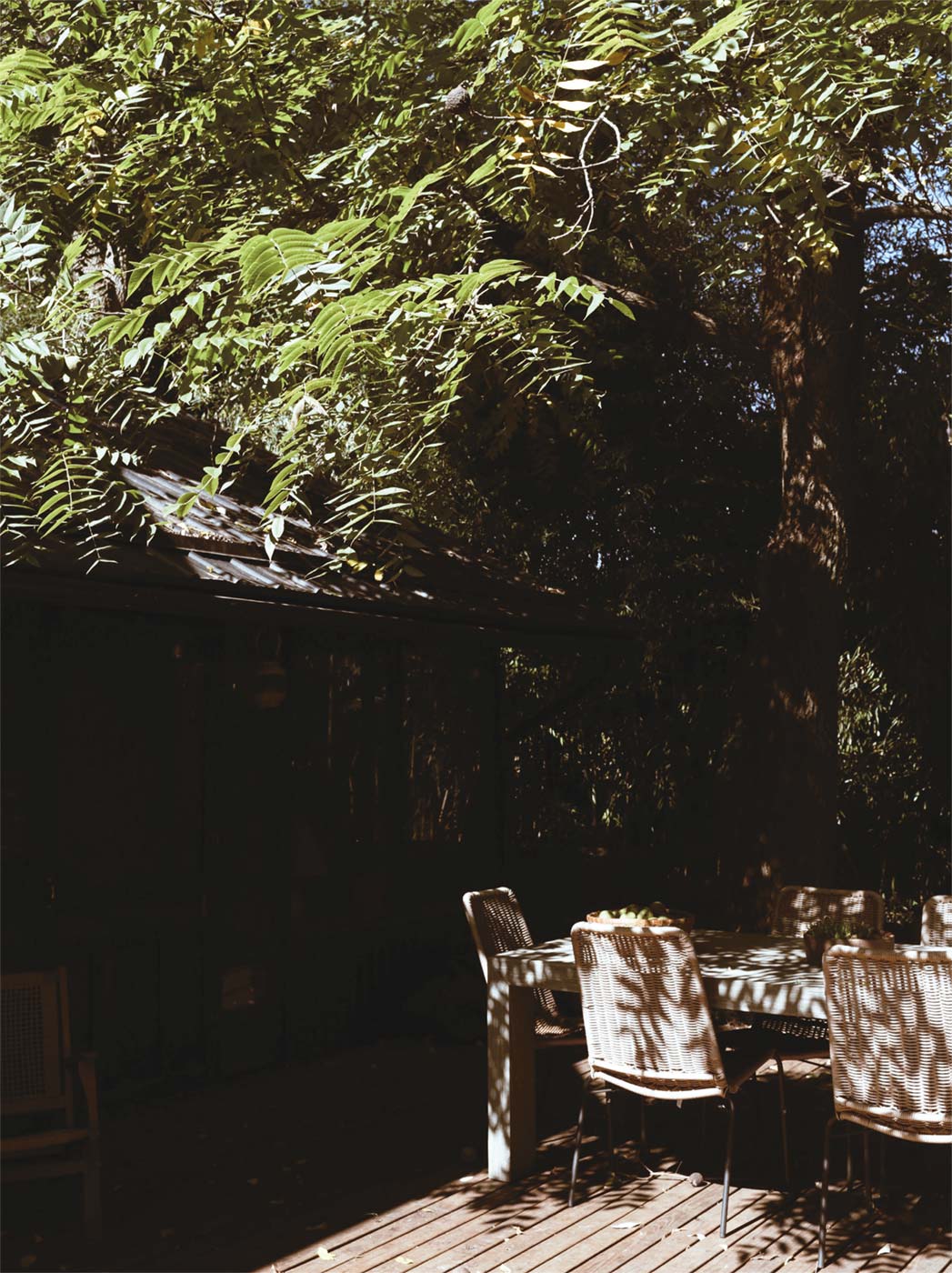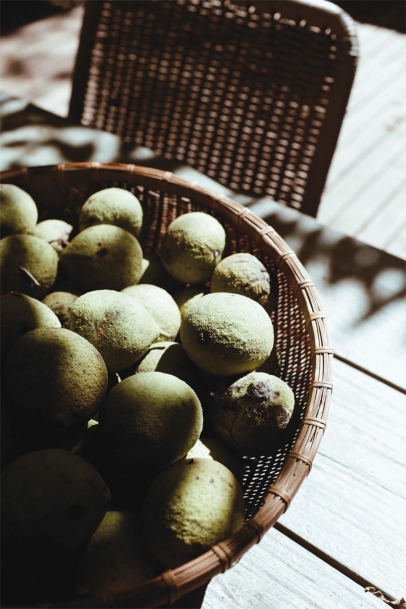The Walnut Tree
The black walnut tree in my garden emerges from the earth, just past the floating cedar porch my wife and I built two years ago in April after ripping out the old sinking brick patio. Wearing gloves to protect our dry winter skin from the rough edges, we removed each brick by hand and marched 752 of them, wheelbarrow by wheelbarrow, down the pea gravel slope to a pair of pallets in the driveway. There is a particular way to stack bricks on a pallet—and like many other things, I didn’t learn this until I needed to know it.
We know very little about our house’s former life before an artist renovated it some 30 years ago, blowing out walls, raising rooflines, closing in the front porch. As the third pair of owners since, we are slowly building shelves of red oak to create a library where there was once an old concrete porch. My wife and I made a deal: Once one section is full of books, we’ll build the next—but I believe she underestimated my ability to procure books, now that I live in 1,600 square feet and not a tenth of that.
The front door faces east, looking out on several Amur honeysuckles that we call “fairy trees,” one crab apple and black cherry tree each, a cluster of bamboo, a line of tall old maples. The back door also faces east, so we do not have traditionally defined yard spaces. We have, quite simply, the garden—and the walnut tree seems to anchor it—all eyes drawn to its sheer size and presence.
Upstairs, the raked windows follow the steep pitch of the roofline, and still I cannot see the crown of the walnut tree. Hanging over the sun porch, the garden, the cedar porch, are the long branches of the walnut tree, the rachis and leaflets creating dappled, shadowy lace when the sun is high overhead.
Last autumn, the heat lingered well into November, and the leaves on the walnut tree did not turn. The first freeze would bring the leaflets and rachis down in a matter of hours, a naked, dead tree from one alive and dressed. Delicate leaves that naturally fall in a whisper became like lead, loud enough to startle me, to wonder what was happening upstairs. I stood at my bedroom window, tucked away inside the walnut tree, where I was a child in a tree house, and watched the walnut shedding the too-long summer in frozen minty green clumps, fast as rain. After each frozen green leaflet had taken leave of the tree, still attached to the stem, the cedar porch disappeared. I could not see the flaking paint on the roof, the grass, the stones I had salvaged from under the old brick patio and carefully arranged around the flower beds. The walnut tree stood bare, her lacy clothes strewn about at her feet.
We worried for our walnut tree last winter, worrying she might not return come spring after the forceful freeze exposed her, stripped her bare without her consent. What would our garden be without the anchor, her arms leafy and full and offering? Spring came, and the maples would begin to bloom, the honeysuckles and the redbuds, the black cherry, the crab apple. We knew she would take her time, as walnut trees do in spring. One of the hackberry trees encircling the back of our studio, usually the last to the party, would sprout a little green at the very tips. Still, the walnut did not return.
We might have never known anything was wrong, that our tree could not hold all she was carrying, until the limb cracked sometime in the dark while we slept, tucked away in the tree house. If we are not looking closely, how do we know what anyone is carrying?

When I was a little girl, my grandfather would send us to the yard to pick up walnuts for a penny each, teaching his granddaughters the value of hard work, an afternoon well-spent. He kept the pennies in a milky green footed bowl on his dresser, the color of the inside of an Andes mint, the color of the walnut leaflets last November when they fell, sparkling with frost. The walnuts in my grandfather’s yard fell in droves, all of those big old trees producing hundreds of bright green spheres, rough to the touch, spicy and heady. I would rub the scent onto my hands and sniff for hours after returning home, wanting to inhale the woods, which I came to associate with the warm love of my grandparents. Each walnut picked up was labor, each penny rightfully earned, a lesson to his granddaughters, who would become women after he was gone. Nothing and no one was beneath us, and everything was for us.
The lone walnut tree in our garden was bare until one morning it wasn’t, perhaps with the right combination of rain and sun and warm days. And then she was leafing out, branches heavy with leaflets and new growth, hanging low over the porch and the garden, her shade thick and comforting. We noticed one walnut first, and then two and three and ten. Our tree had not produced fruit in the first two summers we lived here, and by all accounts the tree should not have yielded such high quantities of fruit and growth after a warm autumn and late, rapid freeze. She surprised us all, coming back with ferocity and fullness, fruit high and low in her sprawling branches. I noticed the branches drooping low in early August, brushing against my face as I clipped basil from the planter box on the porch. Heavy with fruit, with production, and still so strong, stately. We might have never known anything was wrong, that our tree could not hold all she was carrying, until the limb cracked sometime in the dark while we slept, tucked away in the tree house. If we are not looking closely, how do we know what anyone is carrying?
That morning, my eyes opened and focused, the green sharpening into layers of leaflets, brown branches eclipsed by firework bursts of lush, bright life. The walnut tree is the first and last thing I see each day, and sometimes I will sit underneath her or come upstairs to wrap up inside, and still, there is so much I don’t know about her. But I am learning. The fracture was some 30 feet up, on a limb as long or more, perhaps 10 feet from the trunk in a great, broad bend. I scampered out of bed and out to the garden in my skivvies, opening the porch door to a hot rush of air, and followed the limb line to the very end, drinking in the humid summer morning as gulps instead of breath. The walnuts, clustered in twos and threes, had multiplied across the branches and twigs, the boughs heavy with fruit and production. A walnut tree, a mother, a woman, a survivor.
Once a sapling with promise, stripped of her leaves, coming back stronger. This time it will work, she will be okay now, and she will bear this fruit and carry it too. Maybe this will show them; this will say, I am okay. Maybe I will believe it too.
Now it is September, and the leaves are slowly turning to gold. Walnuts fall in great, loud whacks—we cannot sit on the cedar porch for fear of one knocking us out cold. They slam into the roof, plunk into the little dipping pool we made out of a grain bin, clatter as they tumble down the porch steps. She is releasing them, one by one, and her limbs grow lighter. The process is messy, and we take great care to let her find her way again. I let her know it is okay to let go. I stand at her trunk and wrap my arms around her toughened bark.
After many years of chasing summer, I am looking forward to winter. I think of the walnut tree, all those bare branches at rest, and the hope that will come again in spring. n
Writer’s Note: For this piece, the ask was to write about my life on the road and my Airstream renovation business. Yet as I sat down to write, my drafts felt off. I couldn’t find the story. Nomadism, renovating Airstreams, and writing a book on the subject catapulted my name into the public sphere, yet as big as those things may seem, they are a small part of who I am as a whole. I am moving on from the identity I’ve been boxed into or held and wanted to write a piece from where I am today, not where I used to be. I didn’t want to write another version of the same story I’d been telling for nearly a decade, and once I realized where the block was, I wrote this essay with ease. My wife likes to say “When something feels forced or too difficult, it’s not right.” Sometimes, the difficulty is worth overcoming. Other times, the block is there for a reason. When I let my heart lead and not the assignment, I could write—and write something that has meaning to me now, in this season of my life. Sometimes we must let go to move into whatever comes next for us.
This time it will work, she will be okay now, and she will bear this fruit and carry it too. Maybe this will show them; this will say, I am okay.






